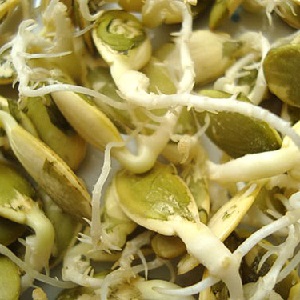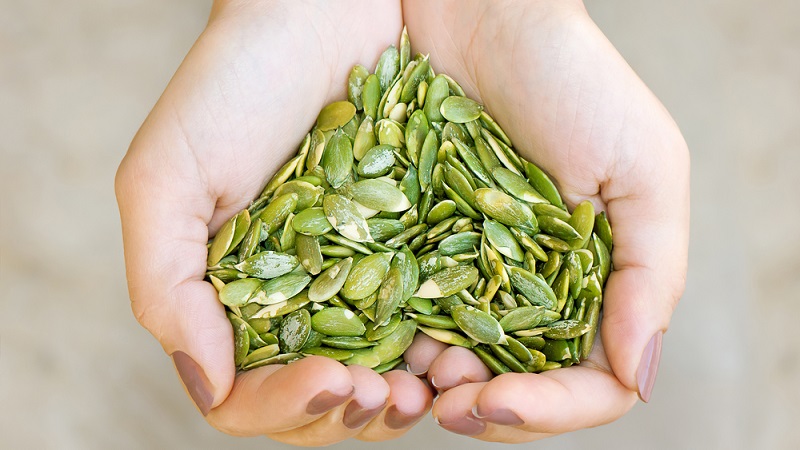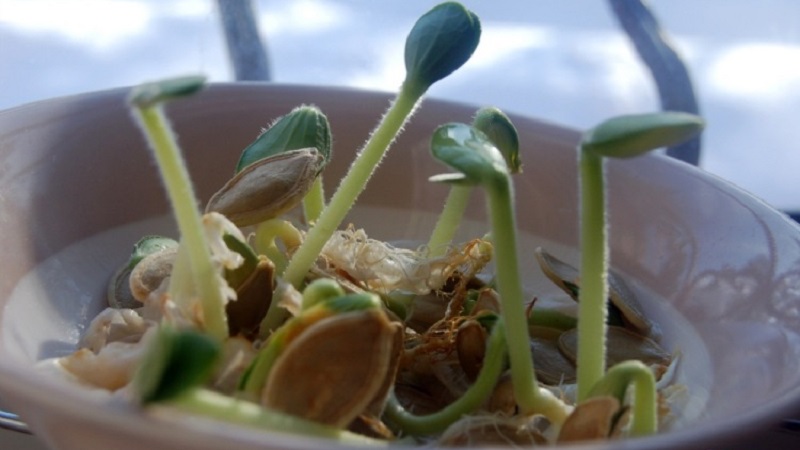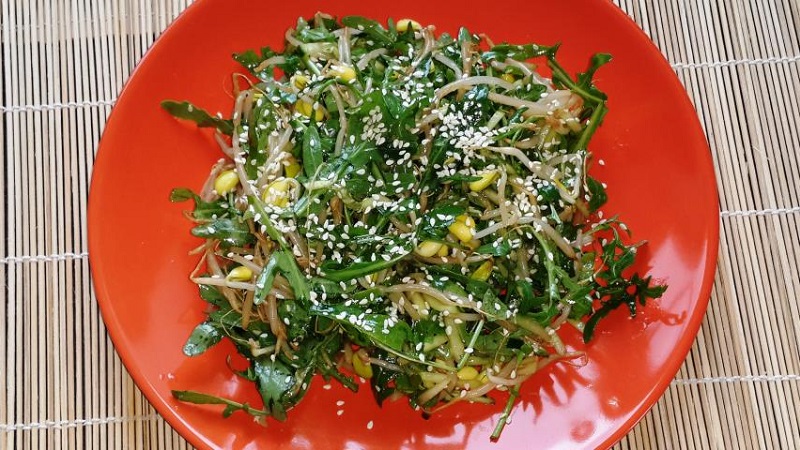Pumpkin sprouts for seedlings and eating at home: how to germinate pumpkin seeds and keep them for a long time
Pumpkin seeds are called a “miniature pharmacy” for a reason - they contain almost all vitamins and minerals. And in sprouted - even more benefits for the human body. This is a real "live food". The composition of the seedlings is different from that of ordinary dried seeds.
In the article, we will tell you in detail how to germinate pumpkin seeds correctly and use them with health benefits.
The content of the article
Composition and useful properties
Pumpkin seeds contain 27-28% protein and up to 50% vegetable oils. They are rich in fiber and omega-3 and omega-6 polyunsaturated fatty acids. There are other useful acids in them: folic, linolenic and glutamic.
Pumpkin seeds contain a huge amount of vitamins: A, E, groups B, T, K, C, P. The content of macro- and microelements is also impressive:
- potassium;
- magnesium;
- calcium;
- phosphorus.
- iron;
- iodine;
- zinc;
- copper;
- selenium;
- chlorine;
- manganese;
- cobalt;
- silicon;
- fluorine.
And in a sprouted form, the benefits of pumpkin seeds only increase. Germination stimulates fermentation and changes the composition of the seeds. Complex proteins and carbohydrates break down into simpler and more easily digestible ones. The amount of vitamins and the content of useful fiber increases tenfold.

How to prepare seed material
The material for germination is collected from vegetables that have ripened even before frost. The cut fruit is kept warm for about a month. Then the pumpkin is carefully cut so as not to damage the seeds - a little on the side, and not in the center. The seeds are removed, peeled from the pulp and washed with cool water. Then they are dried in a warm, dry room.
Attention! Large seeds are chosen for germination, without damage.
Germination methods
Pumpkin seeds germinate slowly and unevenly. On average, it takes 3-6 days before the sprouts appear, depending on the size of the seeds and the chosen method of germination. How to germinate pumpkin seeds, read below.
In a wet wipe / cloth
The traditional way of germinating seeds is on a plate. It is covered with a napkin, paper, gauze or other fabric that absorbs water well (cotton, lignin). Sprouting material is poured on top in one layer and poured with warm boiled water. Until sprouts appear, make sure that the napkin or cloth is always damp.
There is another way: the seeds are poured into a small bag made of linen or linen fabric. It is immersed in water twice a day for one minute and then suspended to let the water glass. The sprouted product can then be stored in the same bag in the refrigerator.
Soaking in a jar
In a jar, pumpkin seeds are germinated as follows: they are poured so that they cover the bottom. The opening of the vessel is covered with a sieve lid or gauze secured with an elastic band. Then several liters of running water are passed through it so that the seeds are washed. After that, clean water is poured into a jar for half its volume and left to soak for 6-8 hours in the usual upright position. Large seeds can be left for 10 hours.
After this time, the jar is placed so that excess water can drain into the container. The vessel is placed in a warm, dark place. The seeds are rinsed with water two to three times a day.Do this until sprouts appear (about 2-3 days).
Council. For this method, it is more convenient to use a sieve lid rather than gauze. On it, the inverted jar stands at an angle due to the protrusion, and air can freely penetrate the jar. Greenhouse conditions are created and seedlings appear faster.
Application of germinated seeds
Sprouted seeds are used for further cultivation of seedlings and consumption. Let's tell you more about each option.
For seedlings
 First of all, pumpkin seeds are heated for a month near a heating device or oven. This increases the chances of getting more female flowers, which means a good harvest.
First of all, pumpkin seeds are heated for a month near a heating device or oven. This increases the chances of getting more female flowers, which means a good harvest.
Purchased seeds can be germinated immediately - they are usually already processed. But if your seeds are harvested from the previous harvest, you must perform the following steps:
- Selection of material. Empty, thin and dry seeds are not suitable for this purpose. They must be checked for germination by soaking in a salt solution. Those that do not drown will not sprout.
- Hardening. The seed, wrapped in a damp cloth, is kept in the refrigerator for three days. This helps the seedlings to quickly adapt to weather changes.
- Disinfection. Soak before planting for 10 hours in a weak solution of potassium permanganate or water with aloe juice.
During germination, the fabric is moistened as it dries. It is important that it is not wet, but moderately damp.
It is convenient to grow seedlings in special peat pots. But if they are not there, homemade containers made of toilet paper will do (when the seedlings are transferred to the beds, it will dissolve in the soil).
For eating
It is better to eat sprouts right away, but you can also leave them in the refrigerator for 1-2 days. The recommended daily allowance is 100 grams 20 minutes before breakfast. Before eating, they should be rinsed with cold boiled water.
White sprouts taste bitter, so you can cut them off and use only the seeds themselves. Or start eating seed already on day 2, without waiting for the appearance of bitter roots. All important processes have already taken place in the swollen seeds.
There is another option for using sprouted pumpkin seeds... Germinate them in the seedling soil until cotyledon leaves appear on them. And these leaves are used for food. In this case, the soil is a mixture of sawdust and river sand in a 1: 1 ratio, previously treated with boiling water.
Tips & Tricks
For germination, gymnosperm pumpkin seeds are more suitable. They do not have a dense shell like other varieties.
To soak the material, it is recommended to use thawed water at room temperature - it quickly removes seeds from hibernation. If you don't have snow on hand, and you don't want to deal with freezing and thawing liquids, you can use another trick. Boiling water quickly cooled to +20 degrees has a good effect.
Important! When soaking pumpkin seeds, remember that overflowing water is more detrimental to them than underfilling. With a layer of liquid more than 1 cm above the seeds, germination will be poor (25-30%).

What are useful
With the regular use of sprouted pumpkin seeds, immunity increases. Sprouts are anti-inflammatory and androgenic.
Their systematic use in food:
- replenishes the deficiency of essential vitamins, minerals and useful acids;
- normalizes water-salt and cholesterol metabolism, the process of hematopoiesis and natural synthesis of insulin; this makes them especially useful for type 2 diabetes;
- cleanses the body of toxins and toxins, heavy metals and salts;
- restores the work of the liver and biliary tract;
- normalizes the genitourinary system;
- improves the functioning of the digestive system;
- normalizes the functions of the reproductive system in men and women;
- increases physical and mental performance, relieves stress and relieves fatigue;
- restores the water-lipid balance of the skin, improves the condition of the skin, hair and nails.
Pumpkin seed sprouts are good for babies too.Their composition helps to increase mental abilities and improve memory, which is important for schoolchildren. Regular consumption of pumpkin seedlings is beneficial for the growth and puberty of adolescents.
Pumpkin seeds are an indispensable product in the diet of pregnant and breastfeeding women. It has everything you need for the full development of the fetus and the mother's body. Vitamin E and folic acid included in the herbal product stimulate lactation and improve the taste of milk.

Recipes
Sprouted pumpkin seeds do not need to be eaten alone. They are added to different recipes: cereals, yoghurts, salads, soups and baking dough. They are combined with vegetables, fruits, nuts and honey. It all depends on your imagination and taste preferences.
Bakery products
Sprouted pumpkin seeds add a special flavor to baked goods. You can safely add up to 1/3 of the total mass to the dough. But if you take a large number of seeds, do not germinate them until sprouts appear - they will reach the required condition in the test. It is enough to pre-soak them for 4 hours, and then add to the kneaded mass.
Pumpkin flour is also made from dried sprouted seeds. For 800 g of wheat flour, take 4 tbsp. l. ground seeds. This enriches the baked goods with easily digestible proteins and increases its organoleptic properties. In addition, such a product remains soft for a long time.
Reference.Pumpkin flour is used as a breading for meat and fish cutlets and schnitzels.
Cold pumpkin soup
For lovers of first courses, there is an excellent recipe for making a cold soup with pumpkin, sprouted pumpkin seeds and celery.
Ingredients:
- pumpkin - 180 g;
- sprouted pumpkin seeds - 60 g;
- apple - 1 pc.;
- celery - 120 g;
- kefir - 300 ml;
- salt to taste.
Preparation:
- Cut the pumpkin pulp into small cubes and steam. Refrigerate.
- Chop the celery, grate the apple on a coarse grater.
- Combine all ingredients and add sprouted seeds.
- Add salt to taste and fill with kefir.
"Megapolzny" sprouted seed salad
Ingredients:
- carrots - 1 pc.;
- sprouted pumpkin seeds - 2 tbsp. l .;
- red pepper - 1 pc.;
- radichio salad and corn - 50 g each;
- juice of half a lemon;
- olive oil - 2 tablespoons l.
Preparation:
- Chop peppers and carrots into thin strips or grate on a coarse grater.
- Combine carrots, peppers, sprouts, and herbs.
- Season the resulting salad with olive oil and lemon juice. You can add a little salt if desired.
- Put the salad in the refrigerator for 15 minutes to steep.

Contraindications
As with any product, pumpkin seeds have contraindications for use. In addition to people with individual intolerances and allergies, they should be used with caution when:
- increased acidity of the stomach;
- exacerbation of gastrointestinal diseases;
- obesity.
Attention!With ulcers of the stomach and duodenum, gastritis during exacerbation and colitis, pumpkin seeds are strictly prohibited to use.
Storage rules and periods
The seeds should be pre-dried so that they will not deteriorate longer. In a closed glass container, they are stored at temperatures from +3 to +6 degrees for 3-4 days.
Attention! Sprouted seeds are even frozen. In the freezer, they can be stored for about 3 weeks.
Dried
The dried seeds are stored in glass jars or natural fabric bags. Choose a cool, dark place for storage. Peeled seeds are stored in the vegetable section of the refrigerator for about a month, and dry seeds - no more than a year.
Storing food with sprouts
Smoothies and vitamin cocktails with sprouted seeds can be stored in the refrigerator for no more than 12 hours. But it is best to consume them within 6 hours of preparation.Pastries can be stored for 3 to 5 days at room temperature.
Raw candies made from sprouted seeds have the longest shelf life. Honey is added as a natural preservative. Such sweets will not disappear in the refrigerator for 5 days.
Conclusion
Pumpkin seeds are a real storehouse of vitamins and microelements. These little helpers, fighting various diseases, help to prolong and improve the quality of life. One tablespoon of sprouted pumpkin seeds per day is enough to maintain health. However, you should not consider them a panacea for all diseases.
Before you start consuming sprouted seeds regularly, make sure that you have no contraindications. Otherwise, such a product will not only not be beneficial, but also harm the body.